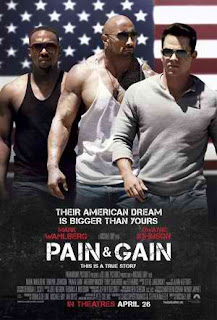2 stars (out of four)
The World’s End
starts promisingly as a the-boys-are-back-together comedy, slips into sci-fi
mediocrity roughly a third of the way in, and ends with a slapdash epilogue so
lazy, it feels like an insult, or maybe a mistake. The film was directed by
Edgar Wright and written by Wright and Simon Pegg, who previously collaborated
on the zombie comedy Shaun of the Dead and the (even better) tongue-in-cheek buddy cop movie Hot
Fuzz. In both of those earlier films, as
well as this one, Wright and Pegg meld the comedy of small town caricatures
with more conventional genre-movie entertainment.
Their films also have a wry, distinctly British wit. They
aren’t afraid to go for the jugular (sometimes literally, by way of decapitating
a character), and for the first half hour or so, The World’s End appears willing to mine some good, uncomfortable
laughs from its reunion of middle-aged blokes.
The organizer of this class reunion is Gary King (Pegg), a
hyper, alcoholic mess of a guy. On a whim inspired by some mid-life crisis
combo of boredom and desperation, he decides to get his old mates from high
school back together for an epic pub crawl called the Golden Mile. Twelve pubs
in one night, a pint (or more) in each one, is no easy feat for anyone,
certainly not a group of men pushing forty. As teenagers, their first attempt
at the Golden Mile left them passed out in a field somewhere between pubs nine
and ten, getting sick all over themselves (which is also to say it was a
smashing success).
The friends are played by a charming and accomplished group
of actors that include Paddy Considine, Martin Freeman and Eddie Marsan. Nick
Frost, again taking up his usual sidekick role beside Pegg (though, for the
first time, as the straight man), plays Andy, Gary’s former best drinking buddy
turned teetotaler. An incident from his and Gary’s post-grad years has made him
swear off booze (as well as his friendship with Gary), but darned if his old
friend can’t drag him back out for one more night.
Andy and the rest of the guys eye the former leader of their
group with a mixture of morbid fascination and deep concern. He hasn’t changed
a bit. He even still drives “The Beast,” his 1989 Ford that coughs black fumes
at the slightest bump in the road. For a while, they enjoy the nostalgia of
being in his company, but the sadness of his situation soon sets in. Watch the
worried looks Considine and Freeman exchange when they realize Gary has been
jamming out to the same cassette tape since high school, some twenty years ago.
The first act of the film is rich with moments like that
one, suggesting that The World’s End is
heading for bold, uneasy comedic territory. Pegg’s performance walks a careful
tonal tightrope. Gary is the type of eternally upbeat guy who wants you to have
a blast but just ends up depressing the hell out of you because it’s painfully
obvious how in denial he is.
But an earnest set-up is wasted with a hard left turn toward
science fiction that, this time around, feels forced rather than inspired. A
plot about extraterrestrial robots taking over the guys’ hometown has potential
for satire (they also find that the once colorful characters of their favorite
pubs have been homogenized as a result of corporate buy-outs, a fate that
mirrors the alien takeover) but it belongs in a different movie.
The World’s End’s
jarring shift of gears also allows it to duck out of dealing with the more
complex and interesting issues its characters face, such as settling into
middle age, dealing with alcoholism and the effects of nostalgia.
Instead there are a lot of fight scenes, which are hectic,
decently choreographed, squirt blue synthetic blood all over the actors, but
are nothing special, really. I find it hard to recommend The World’s End even as simple-minded fun when you can just rent
2011’s way cooler, more inventive and way better alien invasion movie Attack
the Block (also produced by Big Talk
Productions, the same company that produces all of Edgar Wright’s films).
Fans of Shaun of the Dead and Hot Fuzz may be
satisfied enough with The World’s End but I’d be surprised if it attained anything near the cult fandom of
those movies. There are enough good scenes and chuckle-worthy jokes to remind
you of Edgar Wright and Simon Pegg’s earlier successes but the movie ultimately
becomes as weary as Gary King does to his friends. You wish it would dispense
with the distractions, grow up and deal with something real.
- Steve Avigliano, 8/28/13












